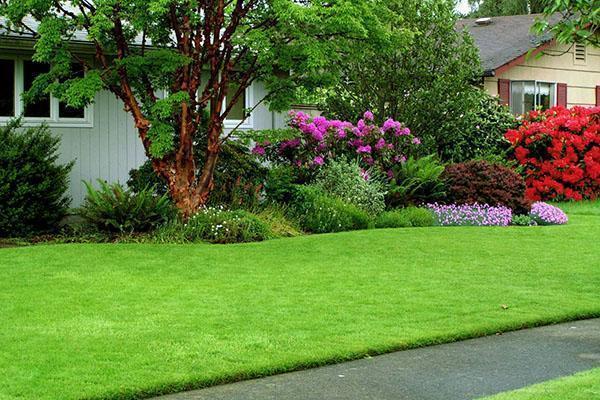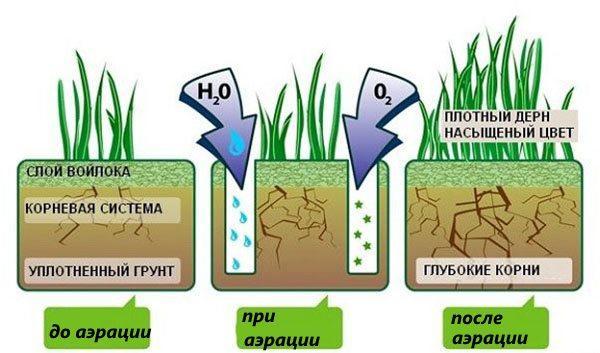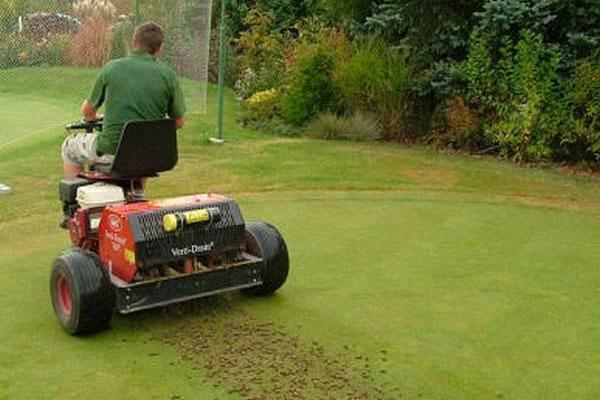The lawn aerator is your reliable assistant
 During operation, the lawn soil is compacted, trampled down. This leads to the destruction of natural capillaries on the surface of the lawn, through which air and moisture penetrate into the depths of the soil. Stagnation of water occurs, the roots of the grass become unable to breathe, soil microorganisms are also in a depressed state. In this case, a lawn aerator is urgently needed to fill the root system with air. This happens by piercing it with metal rods to a depth of ten centimeters.
During operation, the lawn soil is compacted, trampled down. This leads to the destruction of natural capillaries on the surface of the lawn, through which air and moisture penetrate into the depths of the soil. Stagnation of water occurs, the roots of the grass become unable to breathe, soil microorganisms are also in a depressed state. In this case, a lawn aerator is urgently needed to fill the root system with air. This happens by piercing it with metal rods to a depth of ten centimeters.
The diagram shows the condition of the soil and grass before and after the lawn aeration.
Aeration should be done at least once a season if the load on the lawn is not very high and the soil is sandy and light. Under heavy workload or in adverse weather conditions, the operation should be performed more often. Dense soil with a high clay content will require two treatments per season.
You will need a lawn aerator when fertilizing and restoring the pavement.
Types of aerators
The simplest aerator that can improve the condition of your lawn is a conventional pitchfork, with which you simply pierce the soil. But the pitchfork can handle small pieces of the lawn, and it is difficult to work with a hand tool in a large area.
The industry offers several types of lawn aerators.
Motorized
 These devices can be equipped with a gasoline or electric engine. In addition, self-propelled aerators can be distinguished, which the operator controls while sitting on the unit itself.
These devices can be equipped with a gasoline or electric engine. In addition, self-propelled aerators can be distinguished, which the operator controls while sitting on the unit itself.
 After harvesting the earthen pellets taken out by the hollow needles of the mechanism to the surface, the lawn appears before us like a green tablecloth full of holes.
After harvesting the earthen pellets taken out by the hollow needles of the mechanism to the surface, the lawn appears before us like a green tablecloth full of holes.
 Another type is a lawn scarifier aerator. This apparatus, in addition to piercing the soil, also collects soil pellets and dry grass in a special container.
Another type is a lawn scarifier aerator. This apparatus, in addition to piercing the soil, also collects soil pellets and dry grass in a special container.
Manual aerators
In addition to self-propelled lawn aerators, there are also smaller manual mechanisms. One of the samples can be seen in the following photo.
 Another type of lawn aerator is the slightly improved tubular forks.
Another type of lawn aerator is the slightly improved tubular forks.
 Aerators made in the form of sandals are interesting in operation. They are simply put on your feet over the shoes and are fixed with straps. Walking in these shoes on the lawn, you can, at the same time, and bring her help.
Aerators made in the form of sandals are interesting in operation. They are simply put on your feet over the shoes and are fixed with straps. Walking in these shoes on the lawn, you can, at the same time, and bring her help.
Such an aerator for lawn easy to do it yourself. It is enough to take plywood, nails, straps and screws. Follow the step-by-step manufacturing process:
- We cut out four blanks from plywood for the sole of your shoes, a pair for each sandal.
- We drill holes in one of the plywood with such a diameter that the nails are firmly held in them. We take nails 100 millimeters long.
- We insert nails into the prepared holes.
- Cover the plywood from the side of the nail heads with the second plywood sole.
- We fasten both plywoods tightly with screws.
- We attach the straps to the product.
- Do the same for the second sandal.
It remains to put on a homemade lawn aerator and walk around the entire area meter by meter. The use of a homemade small tool is relevant on small lawns and narrow areas. You can't walk on large areas for a long time, so it's better to use another model of lawn aerator.
 A homemade aerator can be made larger.To do this, we weld nails to a conventional manual or trailed steel roller. As a result, we get a mechanism similar to the one captured in the next picture. This type of homemade aerator is perfect if you have a mini-tractor or walk-behind tractor. It won't take too long to process the lawn.
A homemade aerator can be made larger.To do this, we weld nails to a conventional manual or trailed steel roller. As a result, we get a mechanism similar to the one captured in the next picture. This type of homemade aerator is perfect if you have a mini-tractor or walk-behind tractor. It won't take too long to process the lawn.